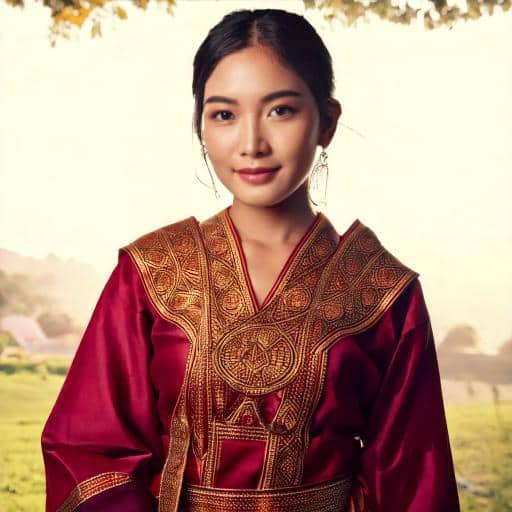The Rich Tapestry of Thai Traditional Dress
Thailand’s cultural heritage shines brightest through its traditional clothing, known locally as “chut thai.” These beautiful garments do much more than simply cover the body—they tell stories of regional identities, social status, and the rich historical tapestry that makes Thailand such a fascinating country. When you choose to wear a traditional Thai costume, whether for a special occasion or simply to connect with Thai culture during your visit to Bangkok, you’re participating in centuries of tradition. At SiamCrown, located in the heart of Bangkok’s historic district, visitors can experience the joy of wearing authentic chut thai while learning about their significance. The careful selection of a Thai costume rental can transform not just your appearance but also your understanding of Thai cultural identity.
Northern Thailand: Elegance and Mountain Heritage
The northern region of Thailand, centered around Chiang Mai and Chiang Rai, boasts some of the most distinctive traditional costumes in the country. Northern Thai clothing, often called Lanna style, features intricate patterns that reflect the mountainous landscape and the region’s historical connections to the ancient Lanna Kingdom. Women’s costumes typically include a long tube skirt (pha sin) with horizontal patterns woven with gold or silver threads. The upper garment features a fitted blouse with long sleeves, often in contrasting colors. What truly sets northern Thai costumes apart is the exceptional quality of hand-woven cotton and silk textiles, which are notably softer than those from other regions. When wearing a northern Thai costume from our thai costume rental collection, you embody the elegant and refined culture of the ancient Lanna civilization, known for its artistic achievements and sophisticated court culture.
Northeastern Thailand (Isan): Simplicity with Vibrant Character
The northeastern region, known as Isan, offers traditional clothing that reflects the practical needs and cultural influences of this once-remote area. Isan costumes tend to feature simpler designs than those from central Thailand, but they compensate with vibrant colors and distinctive weaving techniques. The traditional Isan outfit includes a sinh (skirt) with a bold pattern at the hem, paired with a simple blouse. What makes Isan clothing special is the “mudmee” silk—a technique of tie-dyeing threads before weaving them into magnificent patterns. This creates geometric designs that are completely unique to the region. The northeastern costume speaks of resilience, cultural pride, and the blend of Thai and Lao influences that characterize this fascinating borderland region. Visitors trying on an Isan-style chut thai at SiamCrown often remark on how the outfit’s simplicity carries an unexpected emotional impact, connecting them to Thailand’s agricultural heartland.
Central Thailand: Royal Elegance and National Identity
The central region, home to Bangkok and the historical capitals of Ayutthaya and Sukhothai, features the most widely recognized Thai costumes—those often seen in official ceremonies, at the royal court, and in traditional performances. The women’s traditional central Thai costume consists of a pha nung (wrapped lower garment) paired with a fitted, embroidered blouse. Men wear the distinctive suea phraratchathan (royal-bestowed shirt) with loose pants gathered at the waist and ankles. What distinguishes central Thai costumes is their connection to royal traditions—many styles evolved directly from court dress and consequently feature more elaborate materials, including brocaded silk and gold thread embroidery. When you choose a central Thai costume from our thai costume rental collection, you’re connecting with Thailand’s historical centers of power and the aesthetic that has come to represent Thai national identity worldwide.
Southern Thailand: Maritime Influences and Cultural Fusion
The southern provinces of Thailand present a fascinating cultural blend, with traditional clothing that reflects historical trade connections with Malaysia, Indonesia, and even Middle Eastern merchants. Southern Thai costumes often feature distinctive batik patterns—a technique of wax-resist dyeing that creates complex, colorful designs. Women’s clothing includes the distinctive “pahurat” wrapped skirt paired with a long-sleeved blouse that offers more coverage than central Thai styles, reflecting the region’s strong Muslim influences. The use of bold colors—especially deep reds, blues, and greens—characterizes southern Thai textiles, along with motifs inspired by the abundant marine life of the region. Trying on a southern Thai costume helps visitors understand Thailand’s remarkable cultural diversity and the way coastal communities developed distinctive identities through centuries of international maritime trade. At SiamCrown, we take special pride in our authentic southern Thai costume collection.
The Language of Accessories in Thai Costumes
Beyond the basic garments, traditional Thai costumes include an array of accessories that communicate important social information. The sabai—a shawl-like cloth draped diagonally across the chest—varies in material and decoration depending on the wearer’s status. Jewelry plays a crucial role, with gold necklaces, bracelets, and belt buckles indicating wealth and social position. Even the way fabric is wrapped and pleated carries meaning, with certain styles reserved for specific occasions or life stages. Perhaps most fascinating are the differences in headwear—from the distinctive tall, pointed chada worn by men in classical dance performances to the delicate floral arrangements adorning women’s hair during traditional ceremonies. At our thai costume rental shop, we help visitors select appropriate accessories that complete their chosen regional costume, ensuring an authentic experience that respects Thai cultural traditions.
Modern Adaptations: Thai Costumes in Contemporary Life
While deeply rooted in tradition, Thai costumes continue to evolve in fascinating ways. Modern Thai designers have created contemporary adaptations that maintain cultural authenticity while incorporating practical modifications for today’s lifestyle. These “neo-traditional” designs have helped chut thai remain relevant in contemporary Thai society, especially among younger generations. Recent years have seen a remarkable resurgence of interest in traditional clothing, with Thai celebrities and influencers showcasing elegant adaptations of historical designs at high-profile events. This revival reflects growing cultural confidence and national pride. Visitors to Thailand often notice how traditional elements appear in everyday fashion—from subtle motifs on business attire to full traditional dress for special occasions. When you visit SiamCrown for your thai costume rental experience, our knowledgeable staff can explain how certain modern designs connect to historical traditions.
The Visitor’s Experience: Cultural Understanding Through Clothing
For travelers visiting Thailand, trying on traditional clothing offers a unique window into Thai culture that goes beyond superficial tourism. The experience of wearing a properly fitted chut thai—feeling the weight of silk against your skin, navigating the precise folds of draped fabric, and witnessing your transformed appearance—creates a physical connection to Thai heritage that cannot be achieved merely by viewing costumes in a museum. Many visitors report that their thai costume rental experience gave them new insights into Thai social structures, aesthetic values, and historical development. At SiamCrown, we believe that cultural exchange through traditional dress creates meaningful connections and deeper understanding. Our location at 236 Soi Luean Rit in Bangkok’s historic Samphanthawong district places visitors in the perfect setting to experience Thai cultural heritage while creating unforgettable memories and photographs of their time in Thailand.
Preserving Tradition: The Cultural Importance of Thai Costume Preservation
The preservation of traditional Thai costume-making techniques represents more than nostalgic attachment to the past—it’s an active protection of Thailand’s cultural heritage and artistic achievements. Many of the specialized techniques used in creating authentic chut thai require years of apprenticeship to master, from the complex patterns of mudmee silk to the intricate gold thread embroidery adorning ceremonial garments. These skills connect modern Thai people to their ancestors’ creativity and technological innovation. When visitors choose authentic thai costume rental experiences, they support the artisans and craftspeople who maintain these traditions. Each regional costume style preserves unique aspects of local identity within the broader tapestry of Thai culture. By learning to recognize and appreciate the distinctive characteristics of costumes from different regions, visitors gain a more nuanced understanding of Thailand’s cultural complexity and the way traditional dress continues to communicate important aspects of Thai identity in the modern world.



